Dogs
Are Strawberries Good for Dogs? Essential Guide
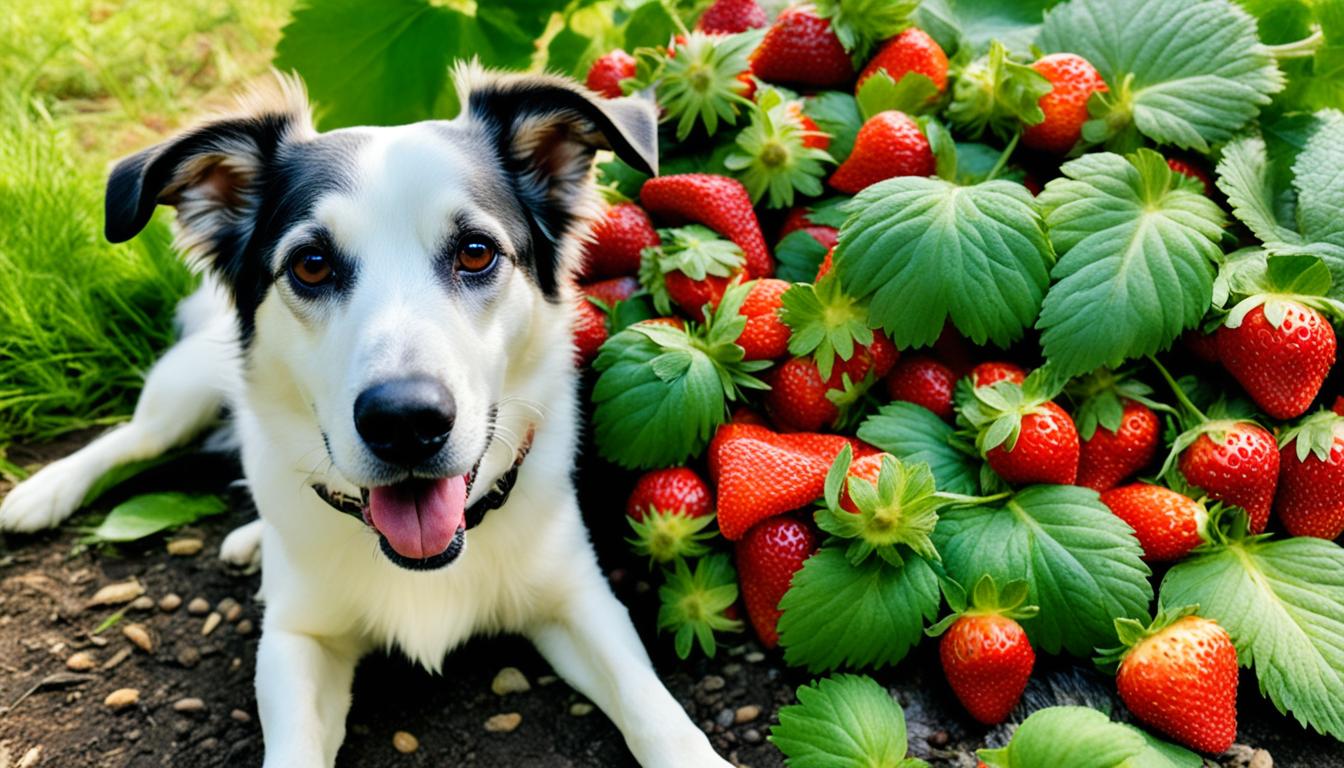
Did you know that strawberries are not only a delicious treat for humans, but also a healthy option for dogs? Strawberries are rich in essential nutrients that can improve your furry friend’s health and well-being. However, before you start giving your dog strawberry snacks, there are some important things you should be aware of.
Key Takeaways:
- Strawberries are safe for dogs to consume in moderation.
- They are rich in antioxidants, vitamins, and minerals.
- Strawberries can promote a healthy immune system and aid in digestion.
- It’s important to follow safe consumption guidelines and be aware of potential risks.
- Consult with a veterinarian for personalized advice on incorporating strawberries into your dog’s diet.
Benefits of Strawberries for Dogs
When it comes to the health of our furry friends, incorporating nutritious foods into their diet is crucial. Strawberries are not only delicious for humans but can also bring a myriad of benefits to dogs. These vibrant red berries are packed with essential nutrients that promote overall wellbeing and support various bodily functions.
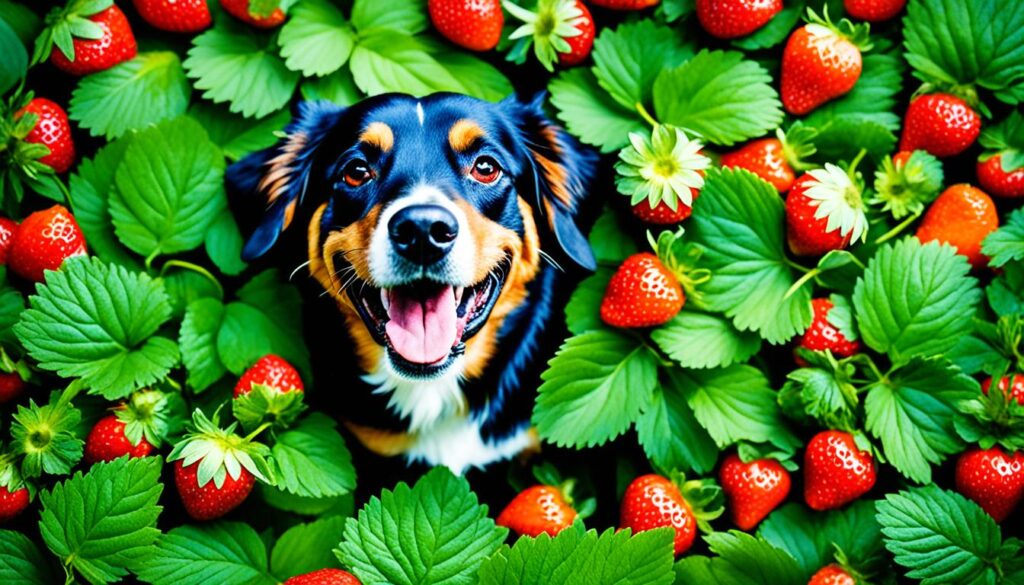
Here are some key health benefits that strawberries offer to dogs:
Promotes a Healthy Digestive System
Strawberries contain fiber, which plays a vital role in maintaining a healthy digestive system in dogs. Fiber aids in proper digestion and prevents common digestive issues such as constipation and diarrhea.
Supports the Immune System
Vitamin C is a powerful antioxidant found in strawberries that helps boost the immune system of dogs. This essential vitamin plays a key role in fighting off harmful pathogens and protecting against illnesses.
Reduces Inflammation
Strawberries are rich in antioxidants that help reduce inflammation in dogs. Inflammation can lead to various health issues and discomfort, so incorporating strawberries into their diet can have a positive impact on overall wellbeing.
Aids in Fluid Balance and Muscle Function
Potassium is a crucial mineral found in strawberries that aids in fluid balance and muscle function in dogs. It helps maintain proper hydration levels and supports healthy muscle contractions.
Contributes to Bone Development and Blood Clotting
Strawberries provide important nutrients for bone development and blood clotting in dogs. They are rich in calcium, iron, magnesium, phosphorus, and vitamin K, all of which play a role in maintaining healthy bones and ensuring proper blood clotting.
By incorporating strawberries into your dog’s diet, you can provide them with these essential nutrients and enjoy the numerous health benefits they offer. However, like any food, moderation is key. It’s always important to consult with a veterinarian before making any significant changes to your dog’s diet.
Potential Risks of Feeding Strawberries to Dogs
While strawberries are generally safe for dogs, it’s important to be aware of the potential risks associated with feeding them this delicious fruit. Here are some of the key risks and dangers to consider:
Choking Hazard:
Strawberries, especially whole ones, can pose a choking hazard for smaller dogs. To minimize this risk, it is essential to cut strawberries into small, bite-sized pieces before offering them to your furry friend.
Stomach Upset:
Natural sugars present in strawberries can cause gastrointestinal discomfort if consumed in excessive amounts. Dogs with sensitive stomachs or those prone to digestive issues may experience diarrhea, vomiting, or an upset stomach. It is best to feed strawberries in moderation, especially if your dog has any preexisting digestive conditions.
Pesticide Residues:
Unwashed strawberries may contain pesticide residues, which can be harmful to dogs if ingested. To minimize this risk, it’s recommended to thoroughly wash strawberries before feeding them to your pet. Opting for organic strawberries can also reduce the potential exposure to pesticides.
By being mindful of these potential risks and taking necessary precautions, you can safely incorporate strawberries into your dog’s diet and enjoy the many benefits they offer.
| Risks | Precautions |
|---|---|
| Choking Hazard | Cut strawberries into small pieces |
| Stomach Upset | Feed strawberries in moderation and monitor your dog’s response |
| Pesticide Residues | Thoroughly wash strawberries before feeding and consider organic options |

Note: Always consult with your veterinarian if you have any concerns or questions about feeding strawberries or any other food to your dog. Their professional guidance will help ensure the safety and well-being of your furry companion.
Safe Consumption Guidelines for Strawberries
When it comes to feeding strawberries to your furry friend, following safe consumption guidelines is essential. Here are some tips to ensure a positive and enjoyable experience:
- Offer strawberries in moderation: While strawberries provide health benefits, they should be given as a treat in moderation. Consider your dog’s size and dietary needs when determining the appropriate portion size.
- Rinse thoroughly: Before serving strawberries to your dog, make sure to rinse them thoroughly. This helps remove any dirt or potential chemicals that may be present on the surface.
- Cut into small pieces: To prevent choking hazards, it’s important to cut strawberries into small, bite-sized pieces. This ensures that your dog can safely enjoy this delicious fruit.
- Remove leaves and stem: While the leaves and stem of strawberries are not toxic to dogs, they can be tough to digest. It’s recommended to remove them before feeding strawberries to your furry companion.
- Consider frozen strawberries: Frozen strawberries can be a refreshing treat, especially during warmer months. They provide a cooling sensation and can serve as a great way to keep your dog hydrated.
- Mashed strawberries: Another way to incorporate strawberries into your dog’s diet is by mashing them and mixing them with their regular food. This can add a burst of flavor and nutrition to their meal.
By following these safe consumption guidelines, you can ensure that your dog enjoys strawberries in a safe and healthy manner.
“Offer strawberries in moderation, rinse thoroughly, cut into small pieces, remove leaves and stem, consider frozen strawberries, and try mashed strawberries as a topping.”
Can Dogs Eat Various Strawberry Items
When it comes to feeding strawberries to your furry friend, not all strawberry items are created equal. Let’s take a look at some common strawberry items and whether they are safe for dogs to consume:
Fresh Strawberries
Fresh strawberries are safe for dogs to eat in moderation. They are packed with nutrients like antioxidants, vitamins, and minerals that can benefit your dog’s health. However, it’s important to remember that strawberries should only make up a small portion of your dog’s overall diet.
Canned Strawberries
Canned strawberries, on the other hand, are not recommended for dogs. They often contain added sugars and preservatives, which can be harmful to your dog’s health. It’s best to stick to fresh strawberries to ensure your furry friend gets the most nutritional benefits without any unnecessary additives.
Strawberry Leaves
Strawberry leaves themselves are not toxic to dogs, but they may pose a choking hazard or cause digestive upset if ingested in large quantities. It’s advisable to remove the leaves before offering strawberries to your dog as a precaution.
Strawberry Yogurt and Ice Cream
While dogs can consume plain yogurt in moderation, strawberry yogurt and ice cream are not recommended. These products often contain high amounts of sugar and potentially harmful additives. Excessive sugar intake can lead to weight gain, dental issues, and other health problems in dogs. It’s best to avoid giving your dog strawberry yogurt or ice cream altogether.
In summary, fresh strawberries are a safe and nutritious treat for dogs when fed in moderation. However, it’s important to avoid canned strawberries, remove strawberry leaves, and steer clear of strawberry yogurt and ice cream due to added sugars and potential harmful additives. Stick to fresh or frozen strawberries without any added sugars or chemicals to ensure your dog can enjoy this tasty fruit while reaping the health benefits.

| Strawberry Item | Can Dogs Eat It? |
|---|---|
| Fresh Strawberries | Yes, in moderation |
| Canned Strawberries | No |
| Strawberry Leaves | No, remove before feeding |
| Strawberry Yogurt and Ice Cream | No |
Impact on Dog’s Health
Incorporating strawberries into a dog’s diet can have a positive impact on their health. The low-calorie content, antioxidants, and various nutrients contribute to overall well-being.
- Strawberries support the immune system and help protect against diseases and infections.
- They contain vitamin C, which acts as an antioxidant and helps reduce inflammation in the body.
- The high fiber content in strawberries promotes a healthy digestive system in dogs.
- Strawberries are a rich source of potassium, which aids in fluid balance and muscle function.
Additionally, strawberries provide essential vitamins and minerals that contribute to specific aspects of a dog’s health:
| Vitamins and Minerals | Benefits |
|---|---|
| Calcium | Supports bone development |
| Iron | Aids in oxygen transportation through the blood |
| Magnesium | Contributes to muscle and nerve function |
| Phosphorus | Helps with energy production and bone health |
| Vitamin K | Plays a role in blood clotting and maintaining pH balance |

In addition, strawberries can help with hydration due to their high water content. They provide a tasty and refreshing way for dogs to stay hydrated. The fun texture of strawberries also adds variety and enjoyment to their meals.
How to Introduce Strawberries to Dogs
When introducing strawberries to dogs, it’s important to follow a gradual approach to ensure their safety and well-being. By keeping a few key considerations in mind, you can make the experience enjoyable for both you and your furry friend.
Start with Small Quantities: Begin by offering your dog a small piece of strawberry to gauge their response. Monitor their behavior and digestive system for any adverse reactions. Every dog is unique, and some may have sensitivities or allergies. Observe them closely to ensure strawberries are well-tolerated.
Watching for Behavioral and Digestive Changes: Pay attention to any changes in your dog’s behavior or digestive functions after eating strawberries. Look out for signs of stomach upset, such as vomiting, diarrhea, or excessive gas. If you notice any adverse effects, discontinue feeding strawberries and consult with your veterinarian.
Thoroughly Washed Strawberries: Before feeding strawberries to your dog, make sure to wash them thoroughly to remove any dirt, pesticides, or potential chemical residues. This step eliminates any potential hazards and ensures that your dog only consumes clean and safe strawberries.
Safe and Digestible Pieces: To make strawberries easier for your dog to eat and digest, it is recommended to cut them into small pieces. This helps prevent choking hazards and allows for better digestion. Small pieces also make it easier to monitor the quantity of strawberries being consumed.
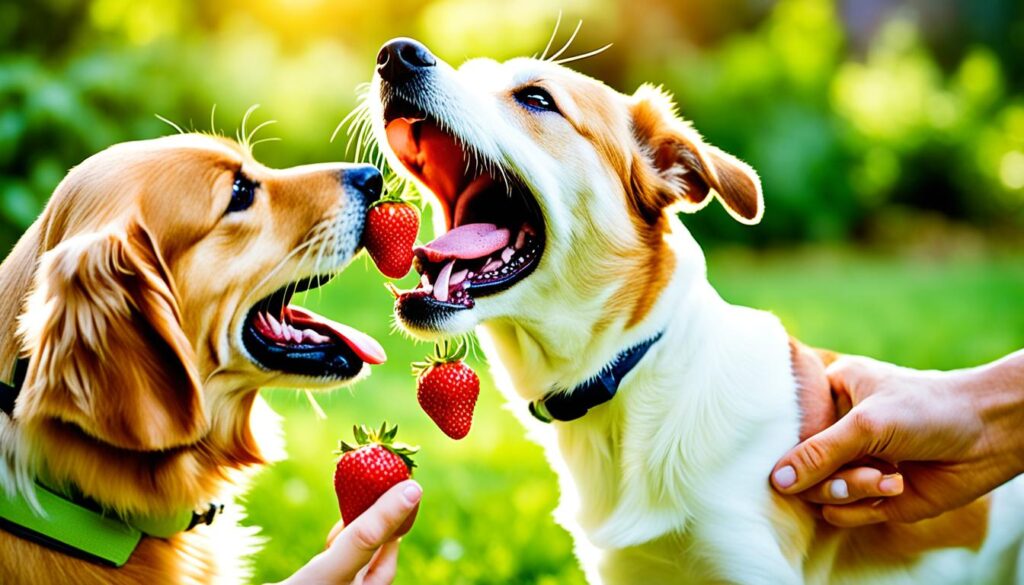
Gradual Incorporation: Just like with any new food, it is essential to introduce strawberries gradually into your dog’s diet. Start by offering them a small portion and assess their response. If there are no adverse effects, you can slowly increase the amount over time. This gradual approach allows your dog’s digestive system to adjust to strawberries and minimizes the risk of gastrointestinal issues.
By following these guidelines, you can introduce strawberries to your dog with confidence. Remember, every dog is different, and it’s important to monitor their individual response to ensure their well-being. Now that you know how to introduce strawberries to your furry friend, let’s explore some other considerations when feeding them this delicious fruit.
Limitations and Considerations
While strawberries can be a tasty addition to your dog’s diet, it’s essential to remember that they should only make up a small portion of their overall food intake. It’s important to consider the limitations and potential risks associated with feeding strawberries to dogs. Here are a few key considerations:
1. Treats should not exceed 10% of their daily calorie intake:
When giving your dog strawberries or any other treats, it’s crucial to keep moderation in mind. Treats, including strawberries, should only account for a small percentage (up to 10%) of their daily calorie intake. This ensures that their main meals meet their nutritional needs while treats remain just that—a special reward or occasional indulgence.
2. Dogs with specific dietary restrictions or health conditions:
Some dogs may have dietary restrictions or health conditions that require modified feeding guidelines. For example, if your dog has diabetes or is on a weight management plan, their strawberry consumption may need to be limited or monitored more closely. It’s always best to consult with a veterinarian to determine the appropriate amount of strawberries or other treats for your dog’s specific needs.
3. Potential digestive issues:
While strawberries are generally safe for dogs, they do contain natural sugars and fiber that can cause stomach upset if consumed in excessive amounts. If you notice any signs of digestive discomfort, such as diarrhea or vomiting, it may be a sign that your dog is not tolerating strawberries well. In such cases, it’s best to reduce or eliminate strawberry consumption and consult with a vet if the issues persist.
4. Pesticide residues and allergies:
Strawberries are part of the “Dirty Dozen” list of fruits and vegetables that are more likely to contain pesticide residue. It’s essential to thoroughly wash strawberries before feeding them to your dog, and consider choosing organic options when available. Additionally, like humans, dogs can be allergic to strawberries. If you notice any signs of an allergic reaction, such as itching, redness, or swelling, discontinue feeding strawberries and consult your veterinarian.
By considering these limitations and taking the necessary precautions, you can ensure that feeding strawberries to your dog remains a safe and enjoyable experience.

Other Fruity Treats for Dogs
In addition to strawberries, there are many other delicious and safe fruits that dogs can enjoy. Including a variety of fruits in your dog’s diet can provide them with essential nutrients and add some tasty variety to their meals. Here are a few examples of nutritious and dog-friendly fruits:
- Apples: Apples are a great source of vitamins A and C, as well as fiber. Remember to remove the seeds and core before offering them to your dog.
- Blueberries: Blueberries are rich in antioxidants and can contribute to your dog’s overall well-being. Serve them as an occasional treat or mix them into their food.
- Watermelon: Watermelon is a hydrating and refreshing fruit that dogs can enjoy. Remove the seeds and rind, and offer small pieces as a summer snack.
- Bananas: Bananas are packed with potassium and fiber. They can be a healthy and low-calorie treat for dogs. Just make sure to remove the peel before feeding.
When introducing these fruits to your dog, start with small portions to ensure they tolerate them well. Monitor their digestion and watch out for any allergic reactions. It’s important to do thorough research on each fruit to understand the potential benefits and risks before including them in your dog’s diet. Remember, moderation is key when it comes to feeding fruits to dogs.
“Adding a variety of fruits to your dog’s diet can provide them with essential nutrients and add some tasty variety to their meals.”
By offering your dog different types of safe fruits like apples, blueberries, watermelon, and bananas, you can provide them with a range of vitamins, minerals, and antioxidants. Experimenting with different fruits can also be a fun and enriching experience for your furry friend.
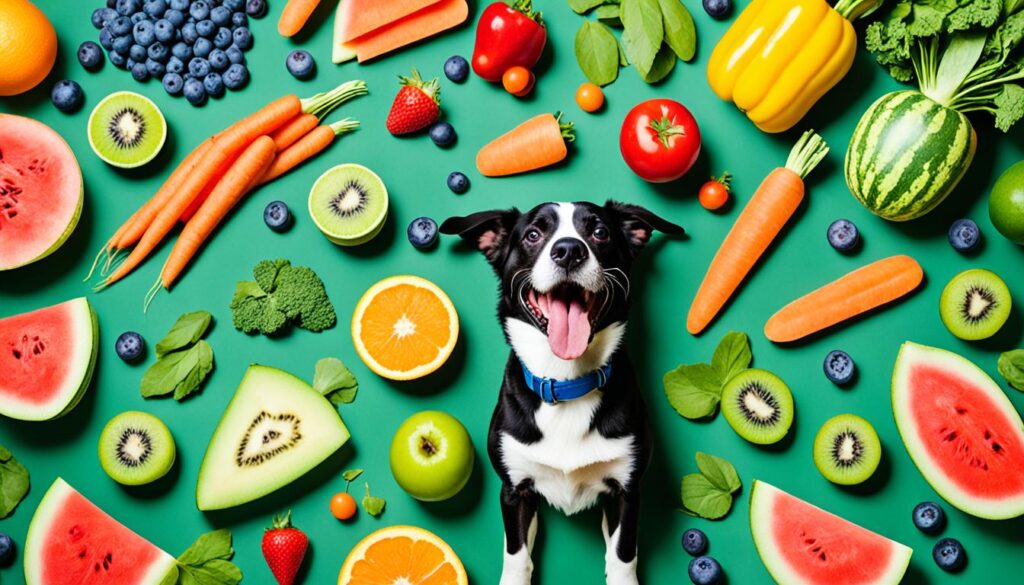
Conclusion
In conclusion, feeding strawberries to dogs can be a delightful and healthy addition to their diet when done responsibly. These vibrant fruits offer a range of nutritional benefits and can be a tasty treat for our canine companions. However, it is essential to adhere to safe consumption guidelines and take into account potential risks and individual dietary needs.
Strawberries provide dogs with valuable antioxidants, vitamins, and minerals that support their overall well-being. The fiber content aids in digestion, while vitamins C and K promote a robust immune system and bone health. By incorporating strawberries into their routine, dogs can enjoy improved hydration, healthy skin and coat, and a delightful texture to their meals.
Nevertheless, it is important to exercise caution when introducing strawberries to dogs. Small pieces should be provided to avoid choking hazards, and excess sugar consumption should be avoided to prevent stomach upset. Additionally, washing strawberries thoroughly and opting for organic options can reduce potential exposure to harmful pesticide residues.
Consulting with a veterinarian is always recommended to ensure individual needs and dietary restrictions are taken into account. Veterinarians can offer personalized advice and guidance on incorporating strawberries into a dog’s diet, ensuring optimal health and well-being.
Remember: Strawberries should be enjoyed in moderation as part of a balanced diet for dogs, and treats, including strawberries, should not exceed 10% of their daily calorie intake.
Final thoughts on strawberries for dogs
- Strawberries are a nutritious and delicious treat for dogs
- They offer antioxidants, vitamins, and minerals that support overall health
- Safe consumption guidelines should be followed, including washing thoroughly and cutting into small pieces
- Strawberries should be fed in moderation and should not exceed 10% of a dog’s daily calorie intake
- Always consult with a veterinarian for personalized advice and to consider individual dietary needs
By responsibly incorporating strawberries into a dog’s diet, we can provide them with a healthy and enjoyable snack that contributes to their overall well-being.
| Benefits of Feeding Strawberries to Dogs | Risks and Considerations | Safe Consumption Guidelines |
|---|---|---|
|
|
|
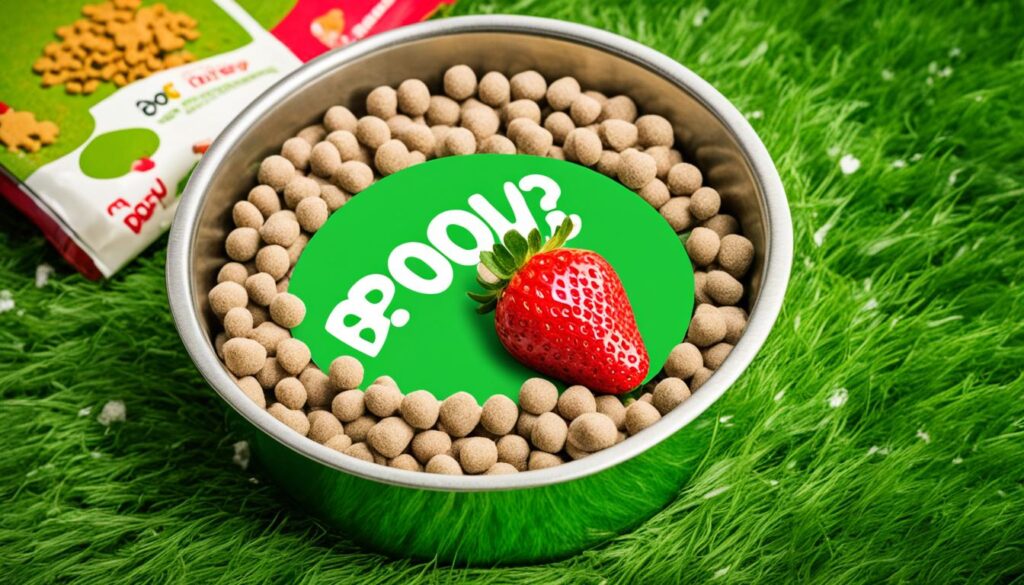
Next Article: Can Dogs Eat Turkey? When to Feed & When to Avoid
The next article will provide valuable insights into the topic of dogs eating turkey. We will explore whether it is safe to feed dogs this protein-rich meat and provide important information on when to feed it and when to avoid it. Our comprehensive guide will cover various considerations such as cooked or raw turkey, the safety of bones, and potential health risks associated with feeding dogs turkey.
Stay tuned for this informative article that will help you make informed decisions regarding your dog’s diet and ensure their health and well-being.

Newsletter Signup
Sign up for our free pet-parenting newsletters to receive expert advice and tailored articles for your beloved pet. At [Company Name], we understand that being a pet parent comes with its unique challenges and joys. That’s why our in-house team of professionals, including veterinarians and behaviorists, are here to provide you with valuable insights and support.
Our newsletters cover a wide range of topics, including pet care advice, behavior training, nutrition tips, health guidance, and much more. Whether you have a playful puppy, a curious kitten, or a loyal senior companion, our newsletters offer relevant and timely information to help you navigate the world of pet parenting with confidence and care.
In addition to helpful content, by signing up for our newsletters, you’ll also gain exclusive access to special discounts and offers from our trusted partner brands. We believe that every pet deserves the best care, and our newsletters are designed to empower you to give your furry friend a happy, healthy, and fulfilling life.
Join our newsletter community today and stay informed about the latest pet care trends, expert advice, and exciting promotions. Sign up now and become part of our thriving community of pet lovers!
FAQ
Are strawberries safe for dogs to consume?
What are the benefits of strawberries for dogs?
What are the potential risks of feeding strawberries to dogs?
How should strawberries be safely fed to dogs?
Can dogs eat other strawberry items?
What is the impact of strawberries on a dog’s health?
How should strawberries be introduced to dogs?
What are the limitations and considerations when feeding strawberries to dogs?
Are there other fruits that are safe for dogs to enjoy?
What are the final thoughts on feeding strawberries to dogs?
What will the next article cover?
How can I sign up for pet-parenting newsletters?
Paul’s love for animals knows no bounds. As a dedicated writer and animal lover, Paul brings a unique perspective to our team. His firsthand experiences with various animals enrich our content and provide valuable insights into their behavior and needs. Whether he’s sharing tips for pet care or shedding light on pressing conservation issues, Paul’s passion for animals shines through in everything he does.
Dogs
The Complete Guide to Paw Patrol Dogs Names
Uncover the dynamic world of PAW Patrol dogs with names like Chase, Marshall, Skye, and more, each with unique talents beginning with the letter 'Y' – a surprise awaits!

Curious about the names of the PAW Patrol dogs? Meet Chase, Marshall, Skye, Liberty, and the Mighty Twins, Tuck and Ella. Chase uses spy gear, Marshall is the fire and medic expert, Skye dominates aerial missions, Liberty is the stylish Dachshund, and the Twins combine strength and smarts. They tackle challenges in Adventure Bay with finesse. Explore further into the world of these heroic pups to discover more about their diverse talents and how they collaborate seamlessly to save the day with their unique abilities.
Key Takeaways
- PAW Patrol dogs include Chase, Marshall, Skye, Rocky, and Everest with unique skills for various rescue missions.
- Each dog has a specific catchphrase like "Chase is on the case!" or "Don't lose it, reuse it!"
- Vehicles such as Chase's Police Cruiser and Skye's Helicopter match their roles for successful rescues.
- Supporting characters like Cap'n Turbot and Tracker contribute specialized expertise to the team.
- Villains such as Sweetie and Sid Swashbuckle challenge the heroic pups in Adventure Bay.
Original PAW Patrol Members
The original PAW Patrol members, led by Ryder, work together to protect Adventure Bay with their unique skills and gadgets. Ryder, the ingenious leader, designs gadgets, vehicles, and outfits for the team.
Chase, the brave German Shepherd, serves as the police dog, equipped with spy gear for top-secret missions. Marshall, the lovable Dalmatian, takes on the roles of fire dog and medic, always ready to lend a helping paw.
Skye, the fearless female Cockapoo, excels in aerial missions as the pilot pup, skillfully piloting her helicopter through the skies. Rocky, the environmentally conscious pup, focuses on eco-friendly initiatives, using recycled items to solve problems and protect the environment.
Together, these dedicated members of the Paw Patrol showcase their individual talents and unwavering commitment to keeping Adventure Bay safe.
Added PAW Patrol Members

Adding to the original lineup, new PAW Patrol members bring unique skills to the team, enhancing their ability to tackle various missions.
Liberty, a long-haired Dachshund, is a recent addition to the squad, showcased in PAW Patrol: The Movie. Alongside the established team, Liberty works tirelessly to save Adventure City from perilous situations.
In the adventurous world of Dino Wilds, the Mighty Twins, Tuck, and Ella, join the PAW Patrol crew, bringing their combined strength and intellect to aid in rescue missions. These added members expand the team's capabilities, ensuring they're well-equipped to handle any challenges that come their way in Adventure City and beyond.
With each new recruit, the PAW Patrol strengthens its unity and effectiveness, demonstrating that teamwork and diversity are key elements in successfully overcoming obstacles.
PAW Patrol Pups Skills
Discussing the skills of the PAW Patrol pups reveals their diverse abilities and essential roles in the team's missions.
Chase shines with his police, traffic cop, and spy skills, adeptly handling police and spy trucks.
Skye, on the other hand, showcases impressive pilot skills, serving as the air rescue pup and skillfully flying a helicopter.
Marshall plays a crucial role as the firedog and medic, skillfully driving a fire truck and ambulance to save the day.
Rocky focuses on eco skills, using recycled items and driving a recycling truck to solve problems creatively.
Lastly, Everest brings her expertise in snow and mountain rescues, skillfully piloting a snowcat for emergencies in snowy terrains.
Each pup's unique set of skills complements one another, making the PAW Patrol team a well-rounded and effective group in handling various missions and keeping Adventure Bay safe.
Recurring Human Characters

Moving on from the PAW Patrol Pups Skills, let's now explore the recurring human characters in Adventure Bay. Mayor Goodway, the leader of Adventure Bay, is often seen with her beloved chicken, Chickaletta, adding a touch of humor to the show. Mr. Porter, the owner of a restaurant, also plays a significant role as Alex's caring grandfather in the series, providing wisdom and support to the community.
Carlos, Ryder's pen pal from the jungle, brings an adventurous spirit to the storyline, introducing exciting and exotic elements to the show. The Princess of Barkingburg, with her royal ambitions, adds drama and elegance to the narrative, creating enchanting story arcs. Raimundo, the kind circus ringmaster, looks after performing animals, infusing the show with a colorful and fun atmosphere.
These recurring human characters enrich the world of Adventure Bay, each contributing unique qualities that enhance the overall Paw Patrol experience.
PAW Patrol Villains List
The PAW Patrol Villains List introduces a cast of antagonistic characters that challenge the heroic pups in Adventure Bay. These villains add an extra layer of excitement and challenge to the PAW Patrol series. Let's explore some of the key antagonists:
- Sweetie: This cunning villain is the princess of Barkingburg, using her intelligence and charm to outsmart the PAW Patrol.
- Sid Swashbuckle: A greedy pirate with a talent for causing trouble, Sid Swashbuckle is always up to no good in Adventure Bay.
- Arrby: As the loyal sidekick of Sid, this mischievous dachshund is known for his clever schemes and sneaky tactics.
- Kitten Catastrophe Crew: These feline troublemakers are the cat counterparts of the PAW Patrol, working under Mayor Humdinger's orders to create chaos.
These adversaries play essential roles in the series, keeping the PAW Patrol on their toes and ensuring every mission is filled with excitement and challenges.
PAW Patrol Special Edition Dogs

Special Edition Pups bring unique skills and qualities to the PAW Patrol team, enhancing their abilities to tackle diverse missions. Liberty, Rex, Wild, Coral, and Al each contribute in their own special way, adding depth and excitement to the group's adventures.
These Special Edition Dogs offer a fresh perspective and expand the team's capabilities, making them valuable assets in the ever-evolving world of Adventure Bay.
Special Edition Pups
With their unique abilities and distinct personalities, the PAW Patrol Special Edition Pups bring a dynamic element to the team.
- Liberty, the long-haired dachshund, is known for her agility and quick thinking during missions.
- Rex, the Bernese Mountain Dog, uses his strength and courage to overcome challenges.
- Al, the Basset Hound, excels in specific rescue missions, thanks to his keen sense of smell and tracking abilities.
- Coral, the Cockapoo and Mer-pup, adds a touch of magic to the team, protecting Puplantis with her underwater skills.
Each of these special edition pups contributes uniquely to the PAW Patrol, showcasing diversity and teamwork in action.
Unique Skills Highlighted
Highlighting their unique skills, the PAW Patrol Special Edition Dogs showcase a diverse range of talents that contribute significantly to the team's success.
Everest excels in snow and ice rescues, skillfully maneuvering her snowcat to save those in need.
Tracker, with his super hearing abilities, is an essential asset during jungle missions, ensuring no one is left behind.
Liberty, the long-haired Dachshund, played a pivotal role in saving Adventure City, showcasing her bravery and quick thinking.
Rex, the Bernese Mountain Dog, fearlessly tackles Dino Rescue missions in Dino Wilds, proving his worth time and time again.
Wild, the ginger tabby cat, brings a fresh perspective to Moto Pups missions, adding a unique touch to the team's endeavors.
Supporting PAW Patrol Characters

We'll now discuss the key supporting characters in PAW Patrol and their essential roles within the team.
These characters play pivotal roles in various missions, each bringing unique skills and abilities to the group.
Understanding the significance of these supporting characters will give us a deeper appreciation of the PAW Patrol team dynamics.
Key Supporting Characters
Key supporting characters in the PAW Patrol team include Cap'n Turbot, Robo-Dog, Everest, Tracker, and Liberty, each bringing unique skills and abilities to assist in various rescue missions.
- Cap'n Turbot, the marine biologist, aids in water-based missions.
- Robo-Dog, the robotic pup, operates multi-member vehicles and communicates through barking.
- Everest, the hyperactive Siberian Husky, excels in snow and ice rescues using a snowcat.
- Tracker, the potcake dog with super hearing, thrives in jungle rescue missions with his jeep.
These characters play essential roles in the PAW Patrol team, contributing their diverse talents to guarantee the success of every mission.
Roles and Importance
Discussing the essential roles and significance of the supporting PAW Patrol characters reveals how each member uniquely contributes to the team's success in various rescue missions.
Cap'n Turbot, the marine biologist, plays a crucial role in water-based missions, utilizing his knowledge and driving skills to assist in aquatic rescues.
Robo-Dog, the robotic pup, adds a technological edge to the team, operating multi-member vehicles and communicating effectively through barking.
Everest, the hyperactive Siberian Husky, specializes in snow and ice emergencies, driving the snowcat with precision.
Tracker, with his super hearing and jungle expertise, navigates the team through dense forests in his jeep for successful jungle rescues.
PAW Patrol Dogs Vehicles

Specialized vehicles tailored to each PAW Patrol dog's unique skills and abilities are vital for successful rescue missions. These vehicles play an essential role in ensuring the safety and efficiency of the team during their missions. Here are some of the vehicles used by the PAW Patrol dogs:
- Chase's Police Cruiser and Spy Truck: Equipped with advanced gadgets for surveillance and tracking, these vehicles help Chase, the police dog, in solving mysteries and apprehending suspects.
- Marshall's Fire Truck and Ambulance: Marshall, the firedog and medic, relies on these vehicles to respond to fire emergencies swiftly and provide medical aid to those in need.
- Skye's Helicopter: Skye, the pilot pup, takes to the skies in her helicopter for air rescue missions, showcasing her exceptional flying skills and ability to navigate challenging terrains.
- Rocky's Recycling Truck: Rocky, the eco-friendly pup, drives this truck to collect and repurpose materials, aiding in solving environmental challenges faced during missions.
Each vehicle complements the skills of the respective PAW Patrol dog, ensuring successful outcomes in every rescue operation.
PAW Patrol Dogs Catchphrases

Individually crafted to reflect their personalities, each PAW Patrol dog's catchphrase serves as a distinctive rallying cry that embodies their unique roles within the team.
Chase, the police pup, confidently declares 'Chase is on the case!' showcasing his investigative prowess.
Marshall, the energetic fire dog, exclaims 'I'm fired up!' capturing his enthusiastic nature perfectly.
Skye, the pilot pup, encourages with 'Let's take to the sky!' reflecting her aerial rescue skills.
Rocky, the eco-conscious recycling pup, reminds everyone to 'Don't lose it, reuse it!' emphasizing the importance of sustainability.
These catchphrases not only add flair to their missions but also provide insight into each pup's character and expertise. Whether it's solving mysteries, fighting fires, soaring through the air, or saving the environment, the PAW Patrol dogs' catchphrases aren't just words – they're powerful declarations of their commitment to helping others and making Adventure Bay a safer place.
Frequently Asked Questions
What Are the Names of the Dogs in PAW Patrol?
We can tell you the names of the dogs in PAW Patrol! Chase, Marshall, Skye, Rocky, Zuma, Rubble, Everest, and Tracker are the main crew members. They work together on exciting rescue missions to keep Adventure Bay safe.
What Is the Order of PAW Patrol Characters?
We'll share the order of PAW Patrol characters with you. Ryder leads the team, followed by Chase, Marshall, Skye, Rocky, and the secondary members. Cap'n Turbot, Robo-Dog, Everest, Tracker, and the Mighty Twins also play important roles in the squad.
Is Zuma a Girl?
No, Zuma from PAW Patrol is not a girl. Despite having a gender-neutral name, he is referred to as a boy in the show. Zuma, a male Chocolate Labrador, is known for his water-related rescues and surfing skills.
Who Is the 6th Pup in PAW Patrol?
We can tell you that Liberty, a brave Dachshund, is the 6th pup in PAW Patrol. She joins the team in PAW Patrol: The Movie, showcasing her loyalty and determination in saving Adventure City.
Can I Use Paw Patrol Dog Names for My Dog with a Name Starting with S?
Yes, you can definitely use Paw Patrol dog names for your dog with a name starting with S. Some sensational dog name ideas from the show include Chase, Skye, and Marshall. These popular names are perfect for any dog, regardless of their own name.
What Are the Names of the Paw Patrol Dogs and Their Breeds?
The Paw Patrol dogs’ names are Chase, Marshall, Rocky, Zuma, Rubble, and Skye. Their breeds are a German Shepherd, a Dalmatian, a mixed breed, a Labrador, an English Bulldog, and a Cockapoo. Finding the dog breed names for each character adds to the charm and diversity of the show.
Conclusion
To sum up, the PAW Patrol dogs have captured the hearts of children and adults alike with their heroic adventures and unique skills.
Did you know that Marshall, the Dalmatian firefighter, is the most popular pup among fans? With his courage and dedication, it's no wonder he's a fan favorite.
Whether it's saving the day or teaching valuable lessons, these pups continue to inspire and entertain audiences around the world.
As our Editor-in-Chief, James plays a pivotal role in ensuring the quality and integrity of our content. With a keen eye for detail and a passion for storytelling, James oversees the editorial process here at A Place for Animals. With years of experience in content editing, James ensures that every piece of content meets our high standards of accuracy and clarity. Under James’ guidance, you can rest assured that the content you read is informative and impeccably crafted.
Dogs
Is Cilantro Safe for Dogs to Eat?

Cilantro can be safe for dogs in small quantities. It is recommended to feed the leaves for easier digestion and use it as a garnish on regular food. Before giving cilantro to your dog, consult with a vet. Be alert for any negative reactions after consumption. Small portions can help prevent stomach issues. Avoid feeding the stems, as they are not safe for dogs. Introduce cilantro slowly to avoid upsetting your dog’s stomach. Remember that your dog’s diet is important. Understanding the impact of cilantro on canines is crucial. Learn more about the effects of cilantro on dogs.
Key Takeaways
- Cilantro is safe for dogs in moderation.
- Start with small amounts to prevent stomach issues.
- Avoid feeding toxic parts like stems.
- Monitor for adverse reactions after consumption.
- Consult with a veterinarian before feeding cilantro.
Safety of Cilantro for Dogs
Cilantro is generally safe for dogs to consume in moderate amounts, providing essential nutrients such as calcium and vitamins. When deciding to feed dogs cilantro, it's vital to focus on the leaves rather than the stems. The leaves are easier to digest and less likely to cause gastrointestinal issues in our furry friends.
To incorporate cilantro into your dog's diet, consider dicing up the leaves and using them as a garnish on their regular food. This method can help avoid stomach irritation and potential food aversion. However, it's always wise to consult with a veterinarian before introducing new foods like cilantro to your dog. Veterinarians can provide personalized advice based on your pet's specific needs and health conditions.
Additionally, it's crucial to monitor your dog for any adverse reactions after consuming cilantro. If you notice any stomach problems or signs of aversion, it's best to discontinue feeding cilantro and consult with your vet promptly.
Moderation Is Key

To prevent digestive upset in dogs, maintaining moderation in feeding cilantro is essential. Here are three key points to keep in mind when offering cilantro to your furry friend:
- Offer in Small Amounts: When giving cilantro to your dog, make sure you provide only a small quantity. Too much cilantro can lead to stomach issues like upset stomach or loose stools.
- Monitor for Signs of Discomfort: Keep an eye on your dog after introducing cilantro into their diet. If you notice any signs of stomach irritation such as vomiting or diarrhea, it's important to stop giving them cilantro immediately.
- Avoid Toxic Parts: Stick to offering the leaves of cilantro to your dog as the stems can be harder for them to digest. By dicing up the leaves and sprinkling a small amount on their food, you can introduce cilantro safely and in moderation. Remember, moderation is key to keeping your pup happy and healthy!
Potential Digestive Issues

Digestive problems can arise in dogs if they consume excessive amounts of cilantro. Some pups may experience an upset stomach or loose stools after eating cilantro.
To prevent these issues, it's important to introduce cilantro in small amounts. By starting with small portions, you can monitor your furry friend for any signs of stomach irritation. If your dog shows symptoms like vomiting or diarrhea, it's best to stop feeding them cilantro immediately.
Keeping a close eye on your dog after introducing cilantro can help you catch any potential digestive reactions early on. Remember, every dog is different, so it's vital to observe how your specific pet reacts to cilantro.
Signs of Stomach Irritation

If your dog starts vomiting or having loose stools after eating cilantro, it could be a sign of stomach irritation. Look out for lethargy or discomfort in your furry friend, as they might indicate an adverse reaction to cilantro.
It's important to pay attention to these signs and stop feeding cilantro if your dog shows any stomach issues.
Vomiting and Diarrhea
After consuming cilantro, vomiting and diarrhea are common signs of stomach irritation in dogs. Here are three things to keep in mind regarding these symptoms:
- Potential Causes: Vomiting and diarrhea can be triggered by the dog's digestive system reacting negatively to cilantro. It might happen due to overconsumption or individual sensitivity.
- Immediate Action: If your dog experiences vomiting or diarrhea after eating cilantro, it's advisable to cease feeding it immediately. This can help prevent further stomach issues and discomfort.
- Monitoring: Keeping an eye on your dog's reaction to cilantro is essential. By observing how your pet responds, you can better understand if cilantro is suitable for its diet.
Lethargy and Discomfort
Lethargy and discomfort in dogs following cilantro consumption often indicate underlying stomach irritation. When your furry friend shows lethargy, such as being unusually tired or sluggish, or discomfort like restlessness or a decreased appetite after eating cilantro, it could suggest digestive issues.
Keep an eye out for other signs of stomach irritation like vomiting or diarrhea. If you notice these symptoms, it's important to stop giving cilantro to your dog and seek advice from a veterinarian promptly.
Monitoring your pet for any hints of stomach irritation is vital, as addressing these issues early can help prevent further complications. Remember, your dog's well-being is a top priority, so always prioritize their health and comfort.
Cilantro Allergies in Dogs

Cilantro allergies in dogs can lead to symptoms like vomiting and diarrhea, indicating a sensitivity to the herb.
If your dog shows signs of adverse reactions to cilantro, it's important to seek guidance from a veterinarian for proper diagnosis and treatment.
Understanding the symptoms, available treatment options, and prevention tips can help manage cilantro allergies in dogs effectively.
Symptoms of Cilantro Allergies
If a dog exhibits symptoms such as vomiting, diarrhea, itchiness, or skin rashes, it may indicate a potential allergic reaction to cilantro. Here are some common signs of cilantro allergies in dogs:
- Vomiting and Diarrhea: Dogs may experience digestive issues like vomiting and diarrhea after consuming cilantro if they're allergic to it.
- Itchiness and Skin Rashes: Allergic reactions to cilantro can manifest as itchiness or skin rashes on a dog's body, indicating a sensitivity to the herb.
- Swelling or Breathing Problems: In severe cases of cilantro allergies, dogs may face swelling, particularly around the face, and even difficulty breathing. If you notice these symptoms, seek veterinary help promptly.
Treatment Options for Allergies
Addressing cilantro allergies in dogs involves exploring various treatment options to alleviate symptoms and improve their well-being. When it comes to pet health, diagnosing allergies in dogs is essential for effective management. Below is a table outlining common treatment options for cilantro allergies in dogs:
| Treatment Options | Description |
|---|---|
| Dietary Changes | Eliminating cilantro from the dog's diet. |
| Medication | Prescribed by a veterinarian for symptom relief. |
| Allergy Testing | Identifying specific allergens for avoidance. |
| Symptom Management | Addressing vomiting, diarrhea, or skin reactions. |
For accurate diagnosis and tailored treatment plans, consulting a veterinary professional is crucial in managing allergies and ensuring your pet's well-being.
Prevention and Management Tips
When managing cilantro allergies in dogs, our primary focus is on prevention and effective symptom management. Here are some tips to help you prevent and manage cilantro allergies in your furry friends:
- Avoidance: If your dog shows signs of cilantro allergies, refrain from feeding them dishes containing cilantro.
- Consult a Veterinarian: Seek advice from a veterinarian to confirm the allergies and receive guidance on managing symptoms.
- Monitor Symptoms: Keep an eye out for vomiting, diarrhea, or skin reactions after your dog consumes cilantro and act promptly if any symptoms occur.
Conclusion and Recommendations

In conclusion, integrating cilantro into your dog's diet can be advantageous when done in moderation and with proper precautions. Dogs can consume cilantro in small amounts to receive essential vitamins and antioxidants that support their overall health.
However, it's important to be cautious as consuming excessive cilantro may lead to an upset stomach in some dogs. When introducing cilantro to your dog, start with a small portion of washed leaves and observe for any adverse reactions or allergies.
Consulting with a veterinarian before adding cilantro to your dog's meals is recommended, especially if your dog has existing health conditions. Remember to avoid feeding your dog the stems of cilantro, as they can be difficult to digest and may cause gastrointestinal issues.
Frequently Asked Questions
How Much Cilantro Can a Dog Eat?
We should limit a dog's cilantro intake to avoid overeating. Moderation is key, so it's best not to exceed 10% of a dog's daily calorie intake with cilantro treats.
Consult a vet before adding new foods to your furry friend's diet. Stick to giving washed, raw cilantro leaves as an occasional snack rather than sharing meals seasoned with cilantro.
Why Do Dogs Love Cilantro?
Dogs love cilantro for various reasons. Its aromatic compounds can appeal to their sensitive noses, making it enticing. The fresh and herbaceous flavor might satisfy their taste buds. Genetic predispositions can also play a role in their preference.
Additionally, the unique taste and smell of cilantro could attract dogs with a fondness for diverse flavors. Individual taste preferences and past experiences may further influence their affinity for cilantro.
Can Dogs Eat Parsley or Cilantro?
Parsley and cilantro are safe for dogs to eat, providing nutritional benefits like vitamins and antioxidants. When offering these herbs to your furry friend, stick to the leaves and skip the stems.
While some dogs may not fancy the taste, others enjoy it. To guarantee your dog's well-being, consult with a vet before adding parsley or cilantro to their diet.
Which Herbs Are Not Good for Dogs?
When it comes to herbs that aren't good for dogs, we need to be cautious. Some herbs like garlic and onion can be toxic to our furry friends, causing serious health issues.
Others, such as rosemary and thyme, should be given in moderation to prevent tummy troubles.
It's important to research and consult with a vet before introducing any new herbs or spices into our dog's diet for their safety and well-being.
Can Dogs Eat Cilantro If They Can Eat Tuna?
Yes, dogs can eat cilantro if they can eat tuna. However, it’s important to ensure tuna safety for dogs by feeding them small amounts without bones or added spices. Cilantro can provide some health benefits for dogs, but it’s best to consult with a veterinarian before making any dietary changes.
Conclusion
To sum up, while cilantro can be safe for dogs in moderation, it's crucial to watch for any signs of digestive issues or allergies.
Keep in mind, every dog is different, so it's advisable to consult with a veterinarian before adding cilantro to your furry friend's diet.
By being cautious and observant, you can guarantee your dog stays healthy and happy.
Stay tuned for more tips on keeping your pet safe and well-nourished!
Dana is our Lead Content Writer, bringing a wealth of knowledge and expertise to our team. With a background deeply rooted in animal studies and a profound love for all creatures, Dana is dedicated to crafting engaging and informative content that resonates with our audience. With Dana at the helm, you can trust that our content is accurate and engaging, catering to the diverse interests of animal enthusiasts everywhere.
Dogs
The Uniqueness of Open Farm Raw Dog Food
Discover the exceptional blend of ethically sourced ingredients in Open Farm Raw Dog Food that sets it apart from the rest, promising a new level of health for your furry friend.

Open Farm Raw Dog Food is known for its unique combination of ethically sourced ingredients, which include 100% pasture-raised lamb and organic fruits and vegetables. These elements not only enhance overall health and vitality, but also support muscle development and energy levels with a high concentration of raw animal protein. By including natural nutrient sources such as essential amino acids and minerals, it caters to a dog’s carnivorous instincts, providing them with the essential nutrients for optimal health. Additionally, Open Farm offers a variety of delicious flavors, convenient feeding options, and a strong dedication to quality and transparency, establishing a new standard in the realm of raw pet nutrition.
This brand's dedication to providing biologically appropriate nutrient sources makes it an excellent choice for pet owners looking to offer their furry companions the best possible nutrition. By combining high-quality ingredients with a focus on health benefits and taste preferences, Open Farm Raw Dog Food caters to the unique needs of dogs and sets itself apart in the market.
Key Takeaways
- Ethically sourced, 100% pasture-raised meats
- High animal welfare certified standards
- Sustainable and transparent sourcing practices
- Variety of delicious flavors and options
- Convenient freeze-dried format for easy feeding
Ethically Sourced Ingredients for Nutrition
Open Farm raw dog food prioritizes nutrition by incorporating ethically sourced ingredients, such as 100% pasture-raised lamb and organic fruits and vegetables. Choosing Open Farm means choosing a diet that not only nourishes your furry companion but also supports sustainable and ethical practices. The lamb in this raw dog food isn't just any lamb; it's sourced from animals raised with care and respect, meeting high Animal Welfare Certified standards. By opting for Open Farm, you're not just feeding your dog; you're making a statement about the values you hold dear.
The inclusion of organic fruits and vegetables adds a vibrant array of essential vitamins and minerals to your dog's diet, promoting overall health and well-being. Knowing that these ingredients are sourced with meticulous attention to quality and ethical standards can provide peace of mind. Every bite your dog takes of Open Farm raw dog food is a step towards a healthier and more sustainable future for both your pet and the planet.
High Percentage of Raw Animal Protein

Open Farm raw dog food boasts a high percentage of raw animal protein, an essential component for canine nutrition.
This protein source is rich in vital nutrients, supporting dogs' overall health and well-being.
With a focus on natural ingredients, this raw animal protein serves as a quality and biologically appropriate nutrient source for our furry companions.
Rich in Animal Protein
With its high percentage of raw animal protein, Open Farm raw dog food stands out for its focus on supporting dogs' muscle development, energy levels, and overall health. The richness of animal protein in this food provides essential nutrients that mimic a dog's natural diet, promoting a biologically appropriate meal.
Here are three key reasons why the high protein content in Open Farm raw dog food is beneficial for your furry companion:
- Muscle Development: The raw animal protein aids in building strong muscles, allowing your dog to stay active and agile.
- Energy Levels: With a diet rich in animal protein, your dog will have the necessary energy to enjoy daily activities and playtime.
- Overall Health: The abundance of raw animal protein supports your dog's overall health, contributing to a balanced and nutritious diet.
Essential for Dogs
Sourced from humanely raised animals, the high percentage of raw animal protein in Open Farm raw dog food is crucial for dogs' best health and muscle development. With a focus on quality ingredients like raw lamb and beef, Open Farm guarantees that your furry companion receives the nutrients needed for peak well-being.
This premium dog food contains 85% animal protein, supporting muscle growth and overall health. By incorporating raw animal protein from ethical sources, Open Farm maintains a dedication to providing dogs with a nutritionally dense diet. Additionally, the inclusion of vegetables in their recipes adds essential vitamins and minerals to promote a balanced diet.
Choose Open Farm raw dog food for a wholesome meal that prioritizes your dog's health and vitality.
Natural Nutrient Source
How does the high percentage of raw animal protein in Open Farm raw dog food contribute to a dog's nutritional needs?
The raw animal protein in Open Farm dog food serves as a natural nutrient source, providing essential amino acids, vitamins, and minerals vital for a dog's health and vitality. Here's why this matters:
- Essential Amino Acids: Raw animal protein in Open Farm recipes ensures that dogs receive all the necessary amino acids for muscle development and overall well-being.
- Vitamins and Minerals: The high-quality raw animal protein from humanely raised sources like grass-fed beef and pasture-raised lamb delivers a rich array of vitamins and minerals critical for a dog's energy levels and overall health.
- Optimal Health: By focusing on raw animal protein, Open Farm promotes a diet that aligns with a dog's carnivorous nature, supporting their optimal health and vitality.
Organic Fruits and Vegetables Incorporation

Incorporating organic fruits and vegetables into Open Farm Raw Dog Food guarantees that your furry companion receives essential nutrients and antioxidants for peak health. These nutrient-rich ingredients, such as blueberries and pumpkin, play a significant role in enhancing your dog's overall well-being. The organic nature of these fruits and vegetables ensures that your pet consumes a diet free from harmful chemicals and pesticides, supporting their immune system and digestion.
By including organic produce in their raw dog food formula, Open Farm prioritizes the quality and nutritional value of each meal. This commitment to using organic fruits and vegetables not only elevates the taste of the food but also contributes to a well-rounded diet that meets your dog's dietary needs.
Choosing Open Farm Raw Dog Food means providing your canine companion with a balanced and wholesome diet that incorporates the goodness of organic fruits and vegetables, essential for their vitality and longevity.
Variety of Delicious Flavors Available

Open Farm's raw dog food line offers a variety of delectable flavors such as Homestead Turkey, Pasture-raised Lamb, Harvest Chicken, Surf & Turf, and Farmers Table Pork. These options cater to different taste preferences, ensuring that every meal is both tasty and nutritious for your furry friend.
With a diverse range of flavors available, pet owners can rotate their dog's diet to keep mealtime exciting and provide a well-rounded nutritional intake.
Flavorful Options for Dogs
Indulging your canine companion with a variety of delectable flavors can enhance their mealtime experience and nutritional intake. Open Farm's pasture-raised raw options offer a delicious and nutritious meal for your furry friend. Here are three flavorful choices your dog can enjoy:
- Lamb Freeze Dried Raw: Made with high-quality, pasture-raised lamb to provide a flavorful and protein-rich meal.
- Beef Freeze Dried Raw: Utilizing grass-fed beef, this option offers a savory and satisfying taste for your dog.
- Surf & Turf: Combining wild-caught salmon and grass-fed beef, this flavor provides a unique blend that appeals to dogs with diverse palates.
These flavorful options from Open Farm help your dog get a balanced and tasty diet, promoting their overall health and well-being.
Tasty and Nutritious Choices
Offering a diverse selection of delicious flavors, Open Farm's freeze-dried raw dog food provides a tasty and nutritious meal for your canine companion. With options like Homestead Turkey, Pasture-raised Lamb, and Farmers Table Pork, your dog can enjoy a variety of flavors made with high-quality ingredients.
The inclusion of vegetables like blueberries and superfoods guarantees that your furry friend receives essential nutrients for overall health. The Surf & Turf variety, combining grass-fed beef and wild-caught salmon, offers a rich source of healthy fats and proteins.
These flavorful choices not only cater to your dog's taste buds but also promote their well-being. Open Farm's freeze-dried raw dog food is a convenient and delicious way to provide a balanced diet for your beloved pet.
Convenient Feeding Options for Pet Owners

When contemplating convenient feeding choices for our furry companions, it's important to prioritize ease of use and nutritional benefits. Open Farm raw dog food offers pet owners like me a stress-free way to provide our dogs with a nutritious diet. Here are some reasons why the convenient feeding options of Open Farm raw dog food stand out:
- Flexibility: The freeze-dried format allows for simple storage and quick use, whether as a complete meal or a tasty topper on regular food.
- Smooth Change: Introducing my dog to a raw diet has never been easier with Open Farm raw dog food, saving me time and effort in meal preparation.
- Essential for All Breeds: The single-protein recipe is suitable for all breeds, making it a convenient feeding solution for pet owners with multiple dogs.
With these convenient options, feeding my dog nutritious raw food has never been simpler.
Secure Packaging for Freshness Assurance
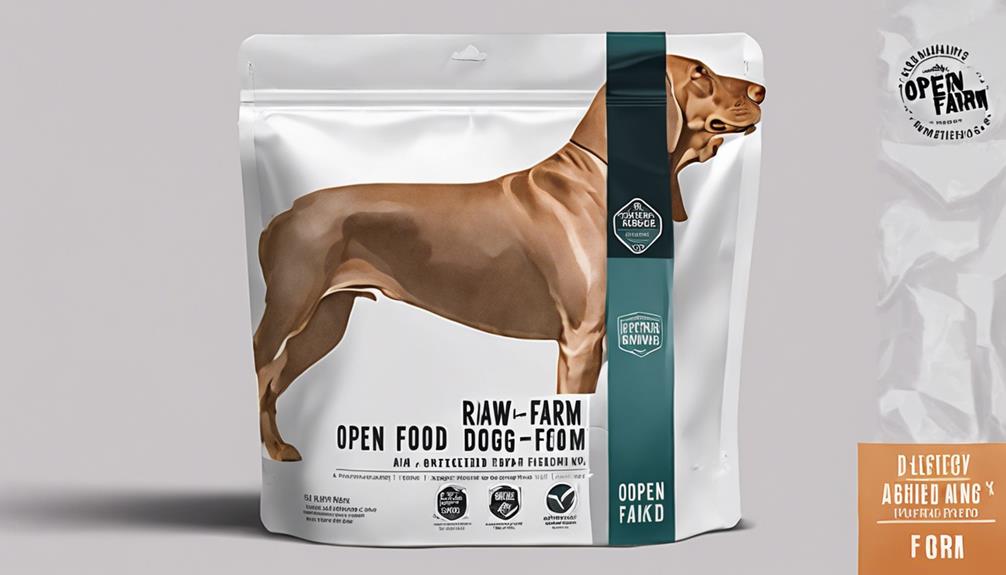
Moving on from the conversation about convenient feeding options, the secure packaging of Open Farm Freeze-Dried Raw Dog Food guarantees freshness and quality maintenance for your pet's meals. The dried food is carefully sealed in each package to make sure it stays fresh and retains all its essential nutrients.
This airtight sealing not only prevents contamination but also keeps the food safe for your dog to consume, giving you peace of mind about the quality of what you're feeding your furry friend. Open Farm's commitment to using quality materials and airtight seals assures the integrity of their raw dog food, maintaining its freshness until the moment you open it.
The packaging design isn't only secure but also convenient for storage, making it easy for you to keep the food fresh and ready for your pet's next meal. With Open Farm, you can trust that your dog's food isn't only nutritious but also handled with care from production to consumption.
Detailed Storage Instructions Provided

By providing detailed storage instructions, Open Farm guarantees the freshness and quality of their raw dog food is maintained for your pet's consumption. Proper storage is essential for keeping raw food at its best. Here's why their guidelines are vital:
- Nutrient Preservation: Storing the food in a cool, dry place away from direct sunlight helps preserve essential nutrients, ensuring your furry friend receives the full benefits of a raw diet.
- Spoilage Prevention: Following the storage instructions prevents spoilage, keeping the food safe for your pet to consume without any worries.
- Extended Freshness: Resealing the packaging after each use is key to maintaining optimum freshness, allowing you to feed your pet high-quality raw food for an extended period.
Open Farm's commitment to providing clear storage instructions not only showcases their dedication to quality but also guarantees that your pet receives the best raw diet possible.
Commitment to Quality and Transparency

Open Farm demonstrates a steadfast dedication to ensuring quality and transparency in their raw dog food products. This commitment is evident in their sourcing of 100% pasture-raised, grass-fed, and finished meats, including raw beef. The brand's rigorous source vetting process guarantees that only humanely raised animals and organic ingredients are used in their recipes, prioritizing both quality and ethical standards. Open Farm's emphasis on transparency goes beyond mere claims, with detailed information provided on the sourcing and processing of every ingredient, ensuring customers are well-informed about what goes into their pet's food. Moreover, the brand's dedication to a climate strategy means sustainable practices and ethical sourcing are at the forefront of their operations. By offering lot number traceability for each ingredient, Open Farm sets a new standard for transparency in the pet food industry.
| Quality Measures | Details |
|---|---|
| Meat Sourcing | 100% pasture-raised, grass-fed, and finished meats, including raw beef |
| Source Vetting | Humanely raised animals and organic ingredients |
| Transparency | Detailed information on sourcing and processing |
| Climate Strategy | Sustainable practices and ethical sourcing |
| Lot Number Traceability | Ensures transparency for every ingredient used |
Wholesome and Unique Diet for Dogs

Crafted with premium ingredients like 100% pasture-raised, grass-fed beef and organic veggies, Open Farm raw dog food offers a wholesome diet tailored to meet the unique nutritional needs of dogs. This wholesome diet is a result of the great sources of nutrients found in each recipe, mixed with organic ingredients that are just right for your pet. When you choose Open Farm raw dog food, you're providing your furry friend with:
- High-Quality Proteins: The 100% pasture-raised, grass-fed beef used in the recipes guarantees your dog receives the essential proteins needed for muscle development and overall health.
- Nutrient-Rich Veggies: The organic vegetables included in the recipes offer a variety of vitamins and minerals that support your dog's immune system and digestion.
- Balanced Nutrition: Each recipe is carefully crafted to provide a balanced mix of proteins, fats, and carbohydrates, making it a complete and well-rounded meal choice for your beloved pet.
Frequently Asked Questions
Is Open Farm Human Grade Food?
Yes, Open Farm raw dog food isn't officially human-grade, but it's crafted with high-quality ingredients that are worthy of humans. The sourcing and production standards are stringent to guarantee quality and safety, making it a great choice for furry friends.
Is Open Farm Aafco Approved?
Yes, Open Farm's raw dog food is AAFCO approved. I've seen the certification myself, which guarantees that it meets the necessary standards for my dog's health. It's a relief knowing I'm feeding her quality food.
How Long Has Open Farm Dog Food Been Around?
Open Farm dog food has been providing premium nutrition for dogs since 2013. Their meticulous ingredient sourcing and high-quality standards set them apart. I appreciate their commitment to sustainability and ethical practices.
Has Open Farm Dog Food Been Recalled?
I haven't found any recalls for Open Farm dog food. They prioritize quality and safety through meticulous sourcing and vetting. Their commitment to transparency and rigorous standards gives pet owners confidence in the brand's reliable and safe products.
Is Open Farm Raw Dog Food Safe for Dogs Who Also Eat Pork Bones?
Yes, you can safely feed pork bones to dogs alongside Open Farm raw dog food. It’s important to give bones in moderation and always supervise your dog while they chew. Cooked bones should be avoided as they can splinter and cause harm, but raw pork bones can be safe for your pup to enjoy.
Conclusion
To wrap up, Open Farm raw dog food offers a unique and wholesome diet for dogs. With ethically sourced ingredients, high raw animal protein content, and a variety of flavors, it's a top choice for pet owners looking to provide their furry friends with nutrition and taste.
One interesting statistic is that over 90% of pet owners who switched to Open Farm raw dog food reported seeing improvements in their dog's overall health and energy levels. Give your dog the best with Open Farm raw dog food.
As our Editor-in-Chief, James plays a pivotal role in ensuring the quality and integrity of our content. With a keen eye for detail and a passion for storytelling, James oversees the editorial process here at A Place for Animals. With years of experience in content editing, James ensures that every piece of content meets our high standards of accuracy and clarity. Under James’ guidance, you can rest assured that the content you read is informative and impeccably crafted.
-

 Vetted6 months ago
Vetted6 months ago15 Best Dog Food Brands Recommended by Vets for Healthy and Happy Pups
-

 Vetted6 months ago
Vetted6 months ago15 Best Affordable Dog Foods That Won't Break the Bank
-

 Cats5 months ago
Cats5 months agoCat Weight Chart by Age: Kitten to Senior in Lbs
-

 Vetted6 months ago
Vetted6 months ago14 Best Homemade Dog Food Recipes Your Pup Will Love – Vet Approved & Nutritious
-

 Vetted6 months ago
Vetted6 months ago15 Best Cat Foods for Managing Hyperthyroidism – Vet Approved and Feline Friendly
-

 Vetted6 months ago
Vetted6 months ago15 Best Dog Foods for Kidney Disease – Expert Recommendations for Your Pet's Health
-

 Vetted6 months ago
Vetted6 months ago15 Best Affordable Cat Foods That Won't Break the Bank
-

 Vetted6 months ago
Vetted6 months ago15 Best Vet-Recommended Dry Cat Foods for Indoor Cats – Keep Your Feline Friend Happy and Healthy



































